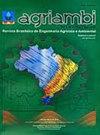木薯栽培土壤在不同管理下的特性
IF 1.4
4区 农林科学
Q3 AGRICULTURAL ENGINEERING
Revista Brasileira de Engenharia Agricola e Ambiental
Pub Date : 2021-11-01
DOI:10.1590/1807-1929/AGRIAMBI.V25N11P764-771
引用次数: 4
摘要
虽然就土壤化学肥力而言,木薯是一种要求不高的作物,但营养物质的缺乏影响了作物的生产力,在自然肥力较低的土壤中种植木薯是常见的,如沿海高原。在此背景下,本研究旨在评价不同管理下木薯栽培土壤的物理和化学特性。该研究是在巴西巴伊亚州沿海高原景观单元的s本文章由计算机程序翻译,如有差异,请以英文原文为准。
Characterization of soils cultivated with cassava under different managements
: Although cassava is an undemanding crop in terms of soil chemical fertility, the scarcity of nutrients affects crop productivity, and it is common to cultivate it in soils with low natural fertility, as occurs in Coastal Tablelands. In this context, the present study aimed to evaluate the physical and chemical attributes of soils cultivated with cassava under different managements. The study was carried out in the municipality of São Felipe, located in the landscape unit of Coastal Tablelands, Bahia state, Brazil. Fifteen properties were selected to evaluate the characteristics of soils cultivated with cassava under different types of management. Soil sampling was carried out during the months of October and November 2018, a dry period in the region. The medium-textured soil was predominant in the different areas of management of cassava cultivation. Most areas showed pH below the recommended range for cassava (5.5 to 6.5), base saturation below 50% and low phosphorus, potassium, calcium, and magnesium contents, according to the crop’s nutritional needs. The first two principal components explained 84.65% of the total variance. Thus, it was possible to verify that the diversity of management of cassava production areas results in high or very high variability of soil chemical attributes. The attributes pH, P, Al, H + Al, V, CEC and OM are the most representative in the distinction of soils of the cassava cultivation areas evaluated.
求助全文
通过发布文献求助,成功后即可免费获取论文全文。
去求助
来源期刊

Revista Brasileira de Engenharia Agricola e Ambiental
Agricultural and Biological Sciences-Agronomy and Crop Science
CiteScore
2.70
自引率
16.70%
发文量
114
审稿时长
3-8 weeks
期刊介绍:
A Revista Brasileira de Engenharia Agrícola e Ambiental (Agriambi), periódico oficial da Asociación Latinoamericana y del Caribe de Ingeniería Agrícola (ALIA), é editada mensalmente, no formato eletrônico, pela Unidade Acadêmica de Engenharia Agrícola (UAEA) do Centro de Tecnologia e Recursos Naturais (CTRN) da Universidade Federal de Campina Grande (UFCG), destinando-se à divulgação de artigos científicos originais e inéditos, elaborados em Português, Inglês ou Espanhol. Com o auxílio de pareceres de Consultores, os artigos são aceitos ou não pela Equipe Editorial para publicação na Revista. A Agriambi aceita, também, a submissão de contribuições na modalidade de revisão de literatura.
 求助内容:
求助内容: 应助结果提醒方式:
应助结果提醒方式:


